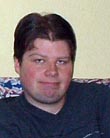|
|
This topic comprises 2 pages: 1 2
|
|
Author
|
Topic: Countdown on Headers
|
|
|
|
|
|
|
|
|
Aaron Sisemore
Flaming Ribs beat Reeses Peanut Butter Cups any day!

Posts: 3061
From: Rockwall TX USA
Registered: Sep 1999
|
 posted 01-27-2002 10:16 PM
posted 01-27-2002 10:16 PM




Michael: As Gord pointed out, the numbers on almost all Academy (11-3) leaders are separated one foot apart, and are a holdover from the silent era. The SMPTE universal leader (the infamous 'Foreigner 4' clock sweep leader that counts from 8 to 2) is exactly 24 frames or one second between the numbers.>>Do any of the big studios use universal heads?<< The studios aren't the ones that do this, it is the labs. The following labs use SMPTE Universal leaders on *release prints*: Technicolor NYC
CFI (now part of Tech Hollywood, so they may have changed to Academy heads by now)
Monaco Film Labs
Atlab Early (late 70s-early 80s) DeLuxe Hollywood prints I have seen can have both Academy and SMPTE leaders on different reels of the same print!
Other labs that normally use Academy leaders for release prints do use SMPTE leaders for non-release elements like workprints and some types of dailies (yes I have seen dailies reels with leaders).
-Aaron
| IP: Logged
|
|
|
|
|
|
|
|
|
|
|
|
|
|
|
|
Frank Angel
Film God

Posts: 5305
From: Brooklyn NY USA
Registered: Dec 1999
|
 posted 01-28-2002 03:42 AM
posted 01-28-2002 03:42 AM





As Paul G said, it really is of no consequence if the sync leader has the countdown numbers spaced in seconds or feet, they are just reference numbers so that the outgoing projector syncs correctly with the incoming projector. The reason I dislike both the SMPTE versions is because they were really designed for TV operation and not theatrical projection. They eliminated one of the features of the Academy leader: the very distinct divisions between the numbers -- the totally black frames contrasting with the transparent number frames. It is always very easy in manual operation to find the number you are looking for because of this obvious visual differentiation. The diamond frame even facilitates racking on frames that are somewhere in between numbers (one booth here requires racking up 4 frames before #9 for near frame-perfect change-overs). With the SMPTE leaders, every frame is the exactly the same density with no distinction between them so you need to look carefully at the leader to find your correct startup frame. With the SMPTE leaders you need to go hunting for a particular slice of the clock to approximate that same distance as the Academy number. What makes it worse, the labs never seem to follow a standard for either density or color with SMPTE leaders; I've seen leaders that vary from almost transparent density to almost opaque, where you couldn't see the numbers or the clock unless you held it up to a bright light -- very inconvenient and prone to error. I always re-mark (as I have seen many other projectionists do) numbers [10], [9] and [8] on equivalent frames. Also, there doesn't seem to be any particular uniformity as to the color of the SMPTE leaders -- I have seen everything from deep blue to a kind of dirty, splotchy pink. I would have thought a leader designed by THE standards organization would have created a standard for the color and density of its own leader. Another disadvantage of the SMPTE leaders in manual operation is that the uniform density does not allow the projectionist to see the "flashes" as the transparent number frames roll through the aperture. We old change-over guys relied on the flashes to mentally count down with the leader and to know to open the dowser after number three flashes. With the uniform density of the SMPTE, there is no flash and with the leaders that are printed very densely, you need to put a piece of artist's tape after number two as your cue to open the dowser. With the leaders that are printed very light, you have to be very careful NOT to open the dowser until the leader passes because it doesn't go to black after number 2, but says that light color right up until the first frame of the film -- open the dowser a second before, and you wind up getting a bright screen of color rather than black. The SMPTE leaders eliminated these visual cues that facilitated good showmanship in theatrical operation and which were part of the Academy leader. Rather it created a need for some sort of additional, projectionist-added cues. I know in the early seventies, when manual change-over booths were still quite prevalent, projectionists that I knew all had the same feeling about the SMPTE leaders -- no one liked them for the above reasons. Some actually felt that the SMPTE had abandoned theatrical needs for the needs of television (TV people hated the Academy leader because the transparent number frames, coming after 15 frames of total black, reeked havoc on the plumbicon tubes in telecine cameras -- what they needed was a neutral density leader which they got in the SMPTE Universal). I think sometime back then I wrote to the SMPTE suggesting that "universality" shouldn't be a goal in and of itself and to admit that it just doesn't work with such divergent needs of exhibition and television; I suggested that there should be a leader specifically tailored for each application rather than one which ignores the needs of one or the other -- in this case, specifically ignoring theatrical exhibition. The suggestions were printed, but the leader stood. A lot of booth guys felt that the SMPTE had abandoned their needs on this one, especially after it was learned that the TV guys on the leader committee were originally pushing hard to make the leader even shorter than the 8 seconds because in TV operation, they don't need to worry about projectors "getting up to speed." Thankfully that idea was voted down. The fact is that the studios never really embraced the SMPTE sync leaders, I think because of these reasons, and the stalwart Academy leader is found on most major releases to this day, more than 30 years later.
| IP: Logged
|
|
|
|
John Pytlak
Film God

Posts: 9987
From: Rochester, NY 14650-1922
Registered: Jan 2000
|
 posted 01-28-2002 12:32 PM
posted 01-28-2002 12:32 PM





Joe Beres said: "I love those rare occasions when I do actually get a print with the "real" academy leader on it. I do run changeover and use those "flashes" whenever possible."Film-Tech participant Jeffry L. Johnson and Jess Daily of the UCLA Film Archive developed standard SMPTE 301 for the new Theater Projection Leader. The black frames are specified as being a neutral density greater than 1.95, and there is a "flash" for each footage number counting down from "11" to "3", just like the original "Academy" leader. The standard also specifies the identification information to be printed on the leaders, and the size and position of the cue marks. ------------------
John P. Pytlak, Senior Technical Specialist
Worldwide Technical Services, Entertainment Imaging
Research Labs, Building 69, Room 7525A
Rochester, New York, 14650-1922 USA
Tel: 716-477-5325 Cell: 716-781-4036 Fax: 716-722-7243
E-Mail: john.pytlak@kodak.com
Web site: http://www.kodak.com/go/motion
| IP: Logged
|
|
|
|
All times are Central (GMT -6:00)
|
This topic comprises 2 pages: 1 2
|
Powered by Infopop Corporation
UBB.classicTM
6.3.1.2
The Film-Tech Forums are designed for various members related to the cinema industry to express their opinions, viewpoints and testimonials on various products, services and events based upon speculation, personal knowledge and factual information through use, therefore all views represented here allow no liability upon the publishers of this web site and the owners of said views assume no liability for any ill will resulting from these postings. The posts made here are for educational as well as entertainment purposes and as such anyone viewing this portion of the website must accept these views as statements of the author of that opinion
and agrees to release the authors from any and all liability.
|

 Home
Home
 Products
Products
 Store
Store
 Forum
Forum
 Warehouse
Warehouse
 Contact Us
Contact Us




 Printer-friendly view of this topic
Printer-friendly view of this topic



















